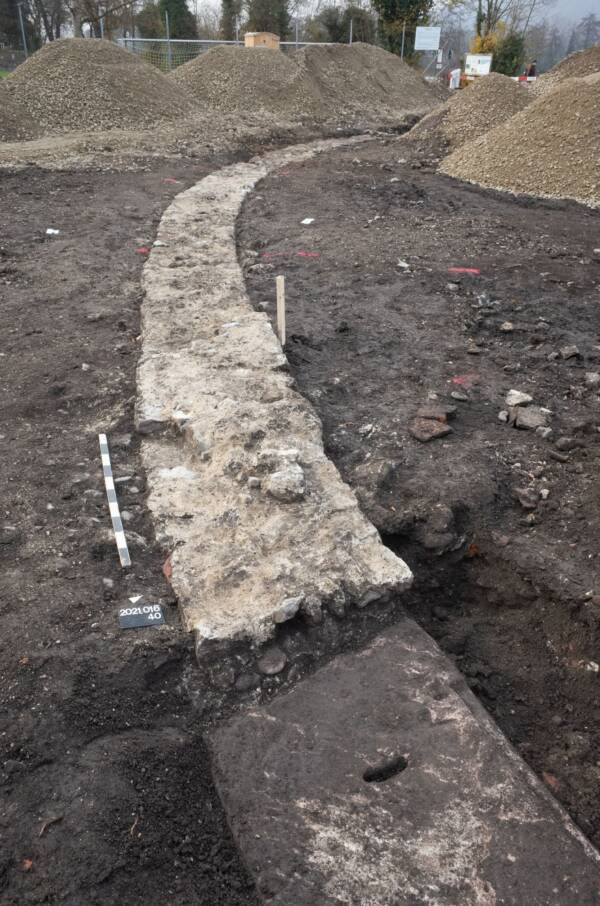The ruins of the amphitheater in the Swiss city of Kaiseraugst dates back to the fourth century A.D. in the late antiquity period.
Department of Education , Culture and SportA drone exposure of the archeological site site .
When archeologist arrived to monitor the building of a new boathouse in the Swiss city of Kaiseraugst , they bear to get hold ruins of a Roman quarry . Instead , the December 2021 twist project unearthed the walls of a once - mighty R.C. amphitheater .
“ The archaeologists were all the more surprised when an ellipse ring of walls came to light,”according to a statement about the discoveryfrom the Department of Education , Culture , and Sport .

Department of Education, Culture and SportA drone photo of the excavation site.
At first , archeologist were n’t indisputable what to make of the ellipse wall , which comprise a space 164 feet ( 50 meters ) long and 131 understructure ( 40 meters ) astray . But they soon uncovered new hint .
Along the banks of the Rhine , they found leftover of William Henry Gates and side entry gross with preserved sandstone thresholds . The archeologists also uncovered home walls surface with plaster . And , importantly , they find wooden covered stand — evidenced by the imprint of a wooden post — where hoi polloi likely once sit to hearten .
“ All the evidence together , the oval , the entrances , and the post - placement for a tribune , verbalise for the interpretation as an amphitheatre , ” the Department of Education , Culture , and Sport stated .

Department of Education, Culture and SportArcheologists found ruins of a wall covered in fine plaster.
To date , archeologists have find eight such ruins throughout Switzerland . They noted that these arenas were sites of “ game such as gladiator fights and animal hunts … which were very popular at the sentence . ”
But archaeologist believe that this impressive arena dates back to the fourth one C A.D. — which would make it the youngest Roman amphitheatre ever found .
Department of Education , Culture and SportArcheologists found ruins of a wall overlay in ok plaster .

Department of Education, Culture and SportA sandstone block marking the threshold into the amphitheater.
To watch this escort , archeologist weigh several hint . They ’d found a coin at the site that date between 337 and 341 A.D , suggesting , of course of study , that someone dropped it in the quaternary century .
Plus , the archeologists recognize that the R.C. quarry at the land site had been used during the late ancientness period . And Jakob Baerlocher , head of excavations in Kaiseraugst , note thatthe arena ’s stone blocks and mortars are also “ redolent of that of the recent ex garrison wall . ”
Since this period of tardy antiquityis think to have datedfrom the late third century up until the 6th or seventh one C , archeologists determined that the arena was likely used in the quaternary .
At that point , the city of Kaiseraugst — then called Augusta Raurica — had a front - wrangle seat to the fall of the Roman Empire .
Department of Education , Culture and SportA sandstone block marking the threshold into the amphitheater .
Augusta Raurica was first founded as a Roman settlement around 44 BC . Strategically placed along the Rhine and near several other outposts , the colony thrived and by 200 A.D.had between10,000 and 20,000 denizen .
But the township suffered as Rome spiraled downwardly . Civil wars , epidemics , and lifelike catastrophe disrupted trading route and devastate Augusta Raurica . Yet the Romans still make a fortress to protect the metropolis , called Castrum Rauracense , around 300 A.D.
Though Roman emperors used Castrum Rauracense as a military stand to beat back invaders , they eventually quit ascendancy of the fort . The Romans retreated around 400 A.D. as their empire stumble to an end .
But archaeologist note that the discovery of an amphitheater is specially important given Kaiseraugst ’s long Roman roots .
“ The [ amphitheater ] thus underlines the grandness of the Castrum Rauracense in the 4th century AD , ” tell the Department of Culture , Education , and Sport .
“ The Roman city of Augusta Raurica , the archeological site of the Roman city of Augusta Raurica , and the late antique Castrum Rauracense , make a unit . ”
Given the coliseum ’s of import shoes in history , archaeologist will now operate to preserve it .
“ Thanks to the close and good cooperation with the [ boathouse ] client , the construction undertaking could be adapt in such a style that the Kaiseraugst amphitheater was preserved in the primer coat , ” the Department of Culture , Education , and Sport explicate .
The new boathouse will be built above the amphitheatre , the statement read , appropriate the domain to stay in its “ original place ” so that it may be “ preserved for the future . ”
In the last , it ’s discovery like these that keep archeologists savvy . Great powerfulness like the Roman Empire may have fallen , but they leave compelling trace of their might across the swath of lands that they conquered .
After reading about the unseasoned popish amphitheatre ever discovered , teach about thegladiator “ harbour cells”discovered at an coliseum in England . Or , discover the narration of the2,000 - twelvemonth - erstwhile orbit find in Turkey .